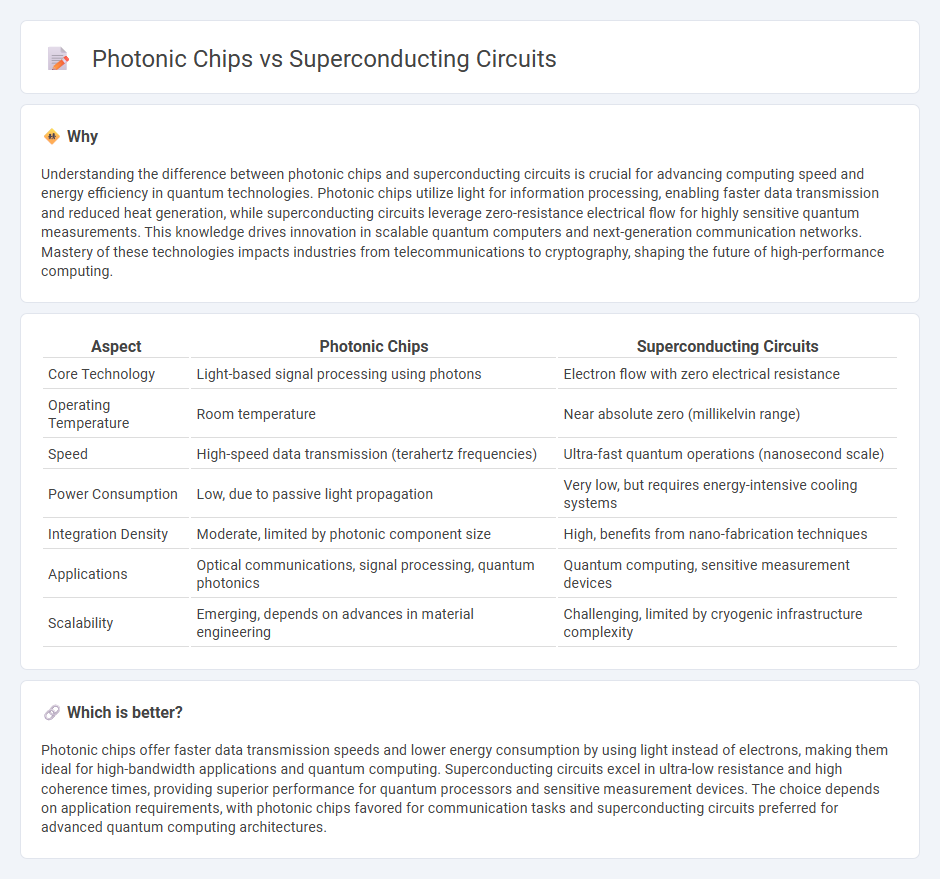
Photonic chips leverage light particles for data transmission, offering ultra-fast speeds and low energy consumption compared to traditional electronic circuits, while superconducting circuits utilize zero-resistance materials to achieve near-perfect electrical conductivity and extremely high processing power at cryogenic temperatures. Both technologies represent cutting-edge advancements in quantum computing and high-speed data processing, yet differ fundamentally in operation, scalability, and cooling requirements. Explore the unique benefits and challenges of photonic chips versus superconducting circuits to understand their potential impacts on future technology.
Why it is important
Understanding the difference between photonic chips and superconducting circuits is crucial for advancing computing speed and energy efficiency in quantum technologies. Photonic chips utilize light for information processing, enabling faster data transmission and reduced heat generation, while superconducting circuits leverage zero-resistance electrical flow for highly sensitive quantum measurements. This knowledge drives innovation in scalable quantum computers and next-generation communication networks. Mastery of these technologies impacts industries from telecommunications to cryptography, shaping the future of high-performance computing.
Comparison Table
| Aspect | Photonic Chips | Superconducting Circuits |
|---|---|---|
| Core Technology | Light-based signal processing using photons | Electron flow with zero electrical resistance |
| Operating Temperature | Room temperature | Near absolute zero (millikelvin range) |
| Speed | High-speed data transmission (terahertz frequencies) | Ultra-fast quantum operations (nanosecond scale) |
| Power Consumption | Low, due to passive light propagation | Very low, but requires energy-intensive cooling systems |
| Integration Density | Moderate, limited by photonic component size | High, benefits from nano-fabrication techniques |
| Applications | Optical communications, signal processing, quantum photonics | Quantum computing, sensitive measurement devices |
| Scalability | Emerging, depends on advances in material engineering | Challenging, limited by cryogenic infrastructure complexity |
Which is better?
Photonic chips offer faster data transmission speeds and lower energy consumption by using light instead of electrons, making them ideal for high-bandwidth applications and quantum computing. Superconducting circuits excel in ultra-low resistance and high coherence times, providing superior performance for quantum processors and sensitive measurement devices. The choice depends on application requirements, with photonic chips favored for communication tasks and superconducting circuits preferred for advanced quantum computing architectures.
Connection
Photonic chips and superconducting circuits intersect in quantum computing by leveraging photons for data transmission and superconducting materials for qubit operation, enabling high-speed and low-loss signal processing. Integrating photonic interconnects with superconducting qubits enhances coherence times and scalability in quantum processors. This hybrid approach promises significant advancements in quantum communication and computational efficiency.
Key Terms
Quantum Coherence
Superconducting circuits maintain quantum coherence through ultra-low temperatures and minimal electromagnetic interference, enabling robust qubit stability for quantum computing. Photonic chips leverage light particles to achieve quantum coherence at room temperature with less susceptibility to thermal noise, supporting scalable quantum communication. Explore the latest advancements in superconducting and photonic quantum technologies to understand their impact on coherence preservation.
Josephson Junction
Josephson Junctions are critical components in superconducting circuits, enabling ultra-fast switching and quantum coherence due to their zero-resistance state and nonlinear inductance. In contrast, photonic chips utilize optical signals for information processing, offering higher bandwidth and lower thermal noise but lacking the intrinsic quantum properties of Josephson Junctions. Explore the distinctive advantages and challenges of Josephson Junctions within these two cutting-edge technologies to understand their impact on quantum computing and photonics.
Integrated Photonics
Superconducting circuits leverage ultra-low resistance and quantum coherence to enable high-performance computational and sensing applications, while photonic chips utilize light for faster, energy-efficient data transmission in integrated photonics systems. Integrated photonics combines various optical components on a single chip, enhancing scalability and functionality for communication and quantum information processing. Explore detailed comparisons and advancements in integrated photonics to understand the future of high-speed, low-power photonic technologies.
Source and External Links
The Ultimate Guide to Superconducting Quantum Computers - SpinQ - Superconducting circuits use Josephson junctions to create qubits that exploit quantum superposition and entanglement, operating at temperatures near absolute zero to maintain quantum coherence for quantum computing applications.
Superconducting circuits - Quantum Technology - Superconducting circuits are made from materials like aluminum or niobium, leveraging macroscopic quantum phenomena and Josephson junctions to form qubits, enabling advanced quantum computation and sensitive measurements at very low temperatures.
Superconducting circuits, simplified | MIT News - These circuits offer zero electrical resistance and very high speed, potentially improving energy efficiency and processing power compared to conventional chips, though they require complex cooling and have engineering challenges.
 dowidth.com
dowidth.com